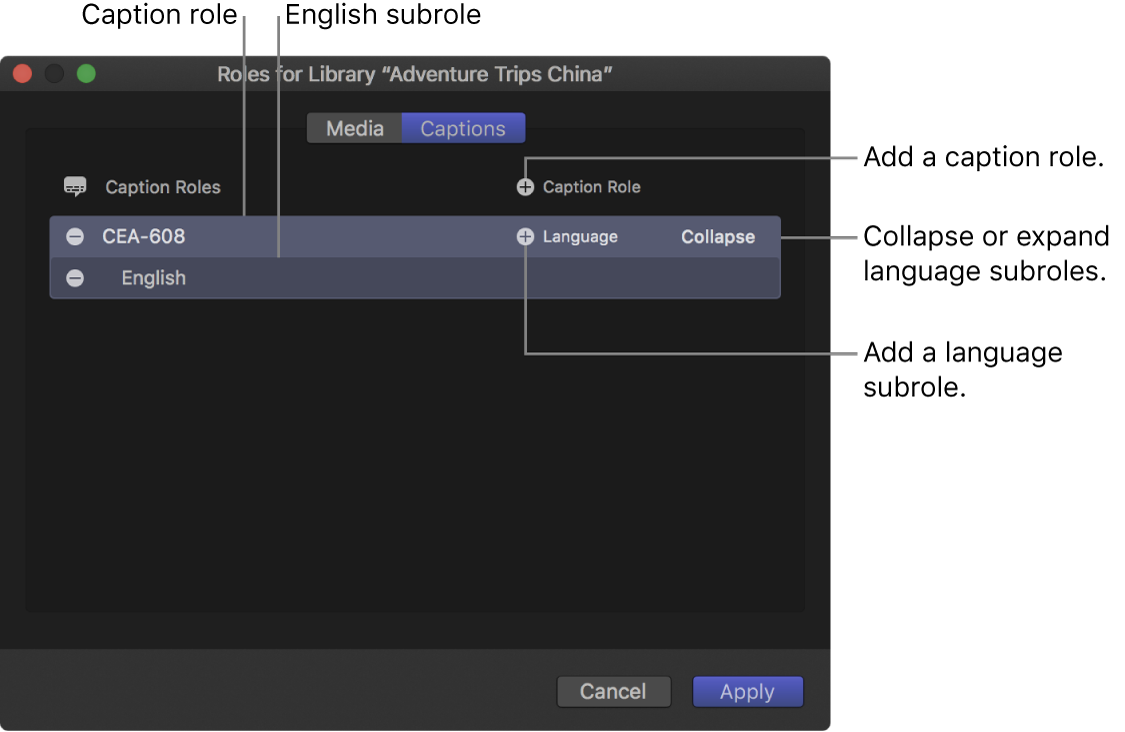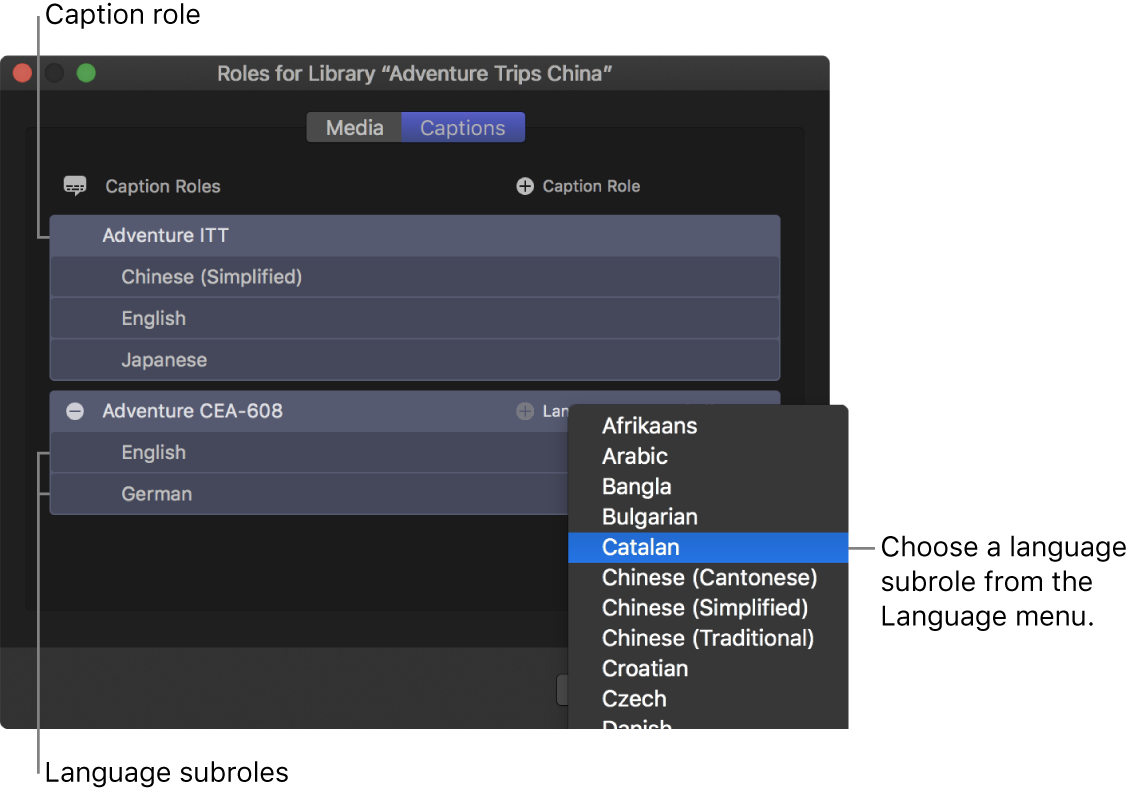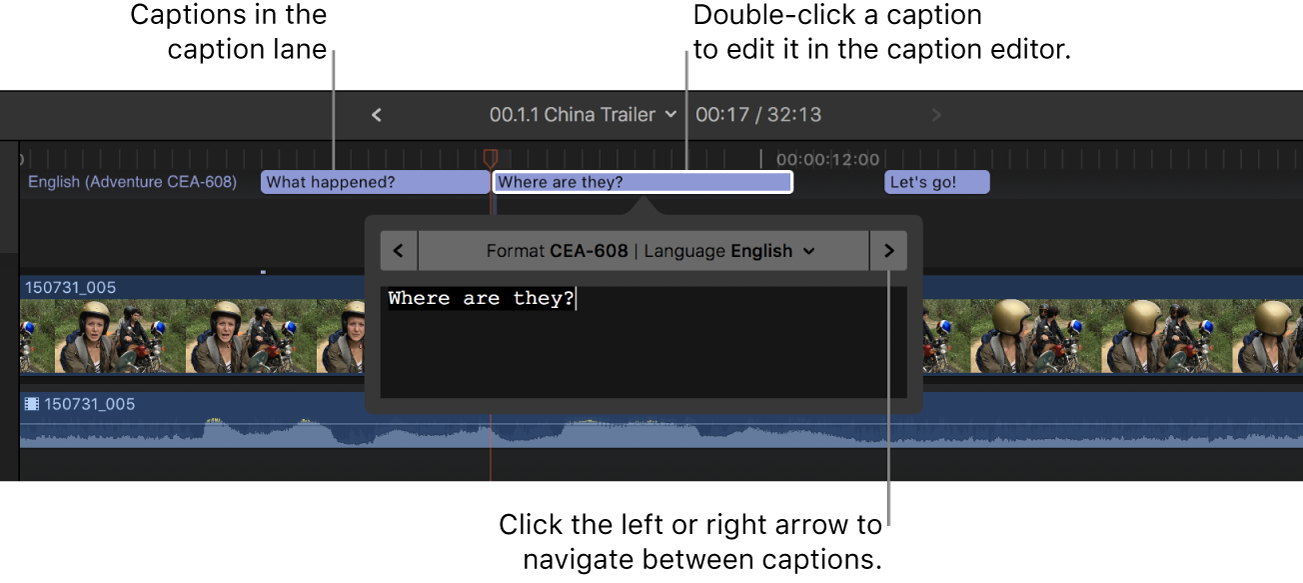Final Cut Pro User Guide
- Welcome
-
- What’s new in Final Cut Pro 10.5
- What’s new in Final Cut Pro 10.4.9
- What’s new in Final Cut Pro 10.4.7
- What’s new in Final Cut Pro 10.4.6
- What’s new in Final Cut Pro 10.4.4
- What’s new in Final Cut Pro 10.4.1
- What’s new in Final Cut Pro 10.4
- What’s new in Final Cut Pro 10.3
- What’s new in Final Cut Pro 10.2
- What’s new in Final Cut Pro 10.1.2
- What’s new in Final Cut Pro 10.1
- What’s new in Final Cut Pro 10.0.6
- What’s new in Final Cut Pro 10.0.3
- What’s new in Final Cut Pro 10.0.1
-
- Intro to effects
-
- Intro to transitions
- How transitions are created
- Add transitions
- Set the default transition
- Delete transitions
- Adjust transitions in the timeline
- Adjust transitions in the inspector and viewer
- Merge jump cuts with the Flow transition
- Adjust transitions with multiple images
- Modify transitions in Motion
-
- Add storylines
- Use the precision editor
- Conform frame sizes and rates
- Use XML to transfer projects
-
- Glossary
- Copyright

Create captions in Final Cut Pro
You can create captions in Final Cut Pro—for example, to deliver your project with subtitles or closed captions.
In Final Cut Pro, captions are assigned special caption roles. To create a new set of captions, you first choose a caption format (CEA-608, iTT, or SRT), then you create a caption role specific to that format and a subrole for each language version.
Captions are always connected clips. Captions can also be connected to other connected clips.
Create caption roles and subroles
To open the Final Cut Pro role editor, do one of the following:
Choose Modify > Edit Roles.
In the Roles pane of the timeline index, click Edit Roles.
Click Captions at the top of the role editor to open the Captions pane.
To create a caption role, click the Caption Role button, then choose a caption format from the pop-up menu: iTT, CEA-608, or SRT.
A new caption role appears in the Caption Roles list in the format you chose. You can change the name of a role at any time by clicking it.
By default, Final Cut Pro creates a caption language subrole based on the preferred language setting in macOS System Preferences. For example, if macOS is set to English, Final Cut Pro creates a subrole for the English language. To change the preferred language setting, choose Apple menu > System Preferences, then click Language & Region.

Type a name for the caption role.
To add another language subrole, move the pointer over the caption role in the Captions pane, click the Language button, then choose a language from the pop-up menu.

The new language subrole appears in the list below the role.
To delete a caption role or a language subrole, move the pointer over the role or subrole, then click the Delete button (–) to the left of the role or subrole name.
Click Apply.
The caption roles and subroles you created are now available to any project in the library. To create the actual captions and assign them to subroles, see Create captions, below.
Note: Choosing a language does not affect what kind of characters can be typed into the captions. Additional steps may be required for some languages. See the macOS Help topic Type in another language with input sources.
Create captions
For the most efficient workflow, make sure the dialogue and related audio in your project are “locked” (completely finished) before you create, sync, or edit the captions.
For example, if you were to add captions and then make changes to dialogue clips later, you might cause the captions to go out of sync with the audio.
In the Final Cut Pro timeline, position the playhead where you want a caption to appear.
Choose Edit > Captions > Add Caption (or press Option-C, or Control-Option-C if the caption editor is already open).
A new caption clip appears at the top of the timeline (in a dedicated caption lane), and the caption editor opens.
The caption is connected to the primary storyline at the playhead position. If a connected clip at the playhead position is selected, the caption is connected to that clip instead. See Connect a caption to a connected clip.
Important: If you move clips earlier or later in the timeline, any connected captions move with those clips. If you delete clips, any connected captions are deleted.
Type text for your caption in the caption editor.

For information about adjusting a caption’s text style, see Format caption text in Final Cut Pro.
Do any of the following:
Create additional captions: Repeat steps 1 through 3 for each new caption.
Edit a caption’s text: Double-click the caption in the timeline (or select it and press Control-Shift-C), then enter your changes in the caption editor.
Tip: You can also double-click a caption in the Captions pane of the timeline index to open it in the caption editor.
If your caption doesn’t conform to the specifications of the caption format you chose (for example, if the caption is too long), the caption turns red in the timeline and in the Captions pane of the timeline index, and a warning message appears in the inspector. See the Apple Support article Learn about Final Cut Pro caption validation.
Note: When the caption editor is open, many single-key keyboard shortcuts (such as J, K, L, I, O, and Space bar) are interpreted as text characters rather than as shortcuts. To use these shortcuts in the caption editor, add the Control key. For example, to play in reverse when the caption editor is open, press Control-J.
Navigate between captions: Click the arrows on either side of the caption editor (or press Command-Right Arrow or Command-Left Arrow).
Adjust a caption’s duration: Drag its start point or end point. See Arrange and trim caption clips in the timeline.
You can also use powerful trimming techniques with caption clips. See Cut clips in two in Final Cut Pro and Extend or shorten clips in Final Cut Pro.
Adjust a caption’s sync with the clip it’s connected to: Drag the caption left or right in the timeline. (When you drag a caption clip, it overwrites adjacent captions.)
